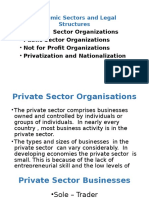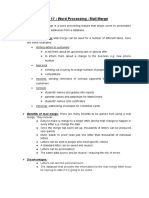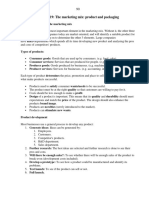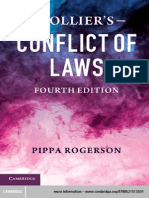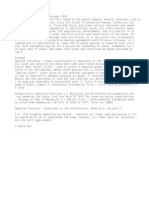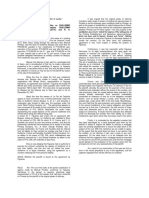Sec1 Part 8
Sec1 Part 8
Uploaded by
emonimtiazCopyright:
Available Formats
Sec1 Part 8
Sec1 Part 8
Uploaded by
emonimtiazOriginal Title
Copyright
Available Formats
Share this document
Did you find this document useful?
Is this content inappropriate?
Copyright:
Available Formats
Sec1 Part 8
Sec1 Part 8
Uploaded by
emonimtiazCopyright:
Available Formats
Section 1: Understanding Business Activity0
Chapter 4 : PART – 8
❖ Partnerships Business:
▪ A business in which 2 to 20 people agree to own it.
▪ Usually small businesses but bigger than sole traders.
▪ Useful for people who want to form a business but don’t want the legal complications
▪ Industries such as medicine or law where you are not allowed to form a company
▪ Partners that know each other very well
▪ Requires a Partnership Agreement
❖ Contents of Partnership Agreement:
• Amount of capital invested by all partners
• Tasks to be done by each partner
• The way profits are shared out
• How long partnership will last
• Arrangements for absence, retirement and how partners could be let known
❖ Private Limited Company (LTD):
➢ An LTD is different from the other because it can sell shares and it is an incorporated business.
➢ Company must be owned by at least 2 shareholders
• A shareholder buys shares of an LTD company which represent part ownership of the company
• Dividend is the amount of profit each shareholder gets
➢ Shares are sold privately to friends and family
➢ Has separate identity from owners, incorporated, so company accounts are separate from the owners’
➢ Must have: Articles of Association and Memorandum of Association
❖ Article of Association – must contain the RULES in which the company will be managed. Contains:
• Rules for shareholder meetings
• List of directors and their jobs
• Voting rights of shareholders
• Details of how accounts are recorded
❖ Memorandum of Association – must contain important information about the company:
• Company name, address
• What the business does
• Number of shares to be sold
❖ Risk, Ownership & Limited Liability:
➢ Risk: the uncertainty of profits or danger of loss, events that could cause business to fail
➢ Ownership: who owns the business (partnership =partners, LTDs and PLCs = the shareholders).The people with risk are usually the
owners
➢ Liability: how much the shareholders of a company are liable for the debts in the business
▪ Limited Liability – liability of shareholders is limited to the amount of money they invested (PLC & LTD)
▪ Unlimited liability – owners of business are held responsible for all the debts of the business (not just their investment) (Sole
trader & partnerships)
❖ Private Limited Companies (LTD) are useful for family businesses or businesses/partnerships where owners want to expand more (as you
can sell shares). Public Limited Company (PLC) is similar to LTD only the shares can be sold to the public. It is the biggest type of business.
Shareholders of PLCs may attend an Annual General Meeting where they may vote for the board directors
❖ Franchise: A business based upon the use of the brand-names, promotional logos & trading methods of an existing business.
▪ The franchisor is the main business/brand; The franchisee is the individual to start up franchise
▪ In a franchise, the franchisor allows the franchisee to trade under its name and see its products for a fee
▪ The franchisee pays an original fee to franchisor and a percentage of its profit for the privilege
▪ Franchisor provides support, such as:
Advertising
Legal advice
Employee training
Financial advice
▪ Franchise agreements last 5 – 20 years, if franchisee cancels the agreement early there may be large fines
▪
❖ Joint Venture: A joint venture is when two or more businesses start a project together sharing capital risks, and profits
You might also like
- Deed of Extra Judicial Settlement of EstateDocument3 pagesDeed of Extra Judicial Settlement of EstateStar B.82% (22)
- SPECIAL POWER OF ATTORNEY - Real EstateDocument2 pagesSPECIAL POWER OF ATTORNEY - Real EstateEryl YuNo ratings yet
- Crosswords Motivation For IGCSE StudentsDocument1 pageCrosswords Motivation For IGCSE StudentsemonimtiazNo ratings yet
- Types of Business OrganisationsDocument26 pagesTypes of Business OrganisationsPreeti SinhaNo ratings yet
- Ch 4 Types of business organizationDocument7 pagesCh 4 Types of business organizationmkw524032No ratings yet
- Chapter 4Document43 pagesChapter 4Fathik FouzanNo ratings yet
- Chapter 4 Types of Business OrganisationDocument46 pagesChapter 4 Types of Business OrganisationKimiko YauriNo ratings yet
- 1.4 Types of Business OrganisationsDocument32 pages1.4 Types of Business OrganisationslafamiliachopraNo ratings yet
- Forms of Ownership of BusinessDocument24 pagesForms of Ownership of Businessaish160502No ratings yet
- Forms of OwnershipDocument6 pagesForms of OwnershipleahNo ratings yet
- Types_of_business_organizationDocument30 pagesTypes_of_business_organizationMumtaj MNo ratings yet
- Chapter 4: Types of Business Organization: Business Organisations: The Private SectorDocument10 pagesChapter 4: Types of Business Organization: Business Organisations: The Private SectorDhrisha GadaNo ratings yet
- UET Entrepreneurship 5Document16 pagesUET Entrepreneurship 5Zain GhummanNo ratings yet
- Tax Considerations:: Factors Affecting The ChoiceDocument26 pagesTax Considerations:: Factors Affecting The ChoiceAnonymous jrIMYSz9No ratings yet
- Business Organization HandoutDocument8 pagesBusiness Organization HandoutSumayah JamesNo ratings yet
- Choosing A Form of Business Ownership - PartnershipDocument22 pagesChoosing A Form of Business Ownership - PartnershipHannah EbueNo ratings yet
- Types of Company StructureDocument15 pagesTypes of Company Structuremwood1scNo ratings yet
- Form of Business OrganizationDocument31 pagesForm of Business OrganizationRudy Hope V. TuraNo ratings yet
- CommerceDocument15 pagesCommerceguptapearl2012No ratings yet
- Types of Business Organisations For ArchitectsDocument14 pagesTypes of Business Organisations For ArchitectsANSLEM ALBERTNo ratings yet
- Forms of Business UnitsDocument115 pagesForms of Business UnitsJaseme Otoyo100% (1)
- Forms of Tourism and Hospitality Business Ownership and FranchisingDocument27 pagesForms of Tourism and Hospitality Business Ownership and FranchisingJulie Mae Guanga Lpt100% (1)
- Chapter 8 Forms of Small Business OwnershipDocument22 pagesChapter 8 Forms of Small Business OwnershipRoxanna Mhae Agarin VidamoNo ratings yet
- The Legal Forms of BusinessDocument76 pagesThe Legal Forms of BusinessAbdou DarboeNo ratings yet
- Business Organizations in India - IT ProjectDocument7 pagesBusiness Organizations in India - IT Projectbhavana.surana2009No ratings yet
- Chapter 4Document10 pagesChapter 4Nelly EurekaNo ratings yet
- Business Basics Handout Types of Business OwnershipDocument5 pagesBusiness Basics Handout Types of Business OwnershipToniann LawrenceNo ratings yet
- Commercial Law in UsDocument19 pagesCommercial Law in Usg.petryszak1No ratings yet
- Forms of Business Organisation and Arrangement Sole Trader and PartnershipsDocument6 pagesForms of Business Organisation and Arrangement Sole Trader and Partnershipsgianniamos11No ratings yet
- Revision NotesDocument60 pagesRevision NotesxalishaxpxNo ratings yet
- Bus SanesDocument7 pagesBus Sanesgodaseganesh12No ratings yet
- Entrepreneurship Unit 1 Understanding Businesses: DR Ella Kangaude-NkataDocument24 pagesEntrepreneurship Unit 1 Understanding Businesses: DR Ella Kangaude-NkataMartin ChikumbeniNo ratings yet
- Week 6- Lecture 1-2.pptxDocument40 pagesWeek 6- Lecture 1-2.pptxdonnquixotNo ratings yet
- TYPES OF BUSINESS OWNERSHIPSwk1Document22 pagesTYPES OF BUSINESS OWNERSHIPSwk1email2n213No ratings yet
- Type of Ventures PDFDocument81 pagesType of Ventures PDFJevonny AndersonNo ratings yet
- MODULE3_1Document66 pagesMODULE3_1kshitijnangare20No ratings yet
- Economic Sectors and Legal StructuresDocument21 pagesEconomic Sectors and Legal Structuresdanielwilo100% (1)
- Session 7Document10 pagesSession 7kalu kioNo ratings yet
- Form A BusinessDocument20 pagesForm A Businessilham suryoNo ratings yet
- Unit 2: Forms of Commercial Organizations: Meaning, Features, Merits and Limitations of The Following FormsDocument35 pagesUnit 2: Forms of Commercial Organizations: Meaning, Features, Merits and Limitations of The Following FormsYashAgarwalNo ratings yet
- Forms of BusinessDocument10 pagesForms of BusinessSeuwandi KeerthiratneNo ratings yet
- Business StructuresDocument22 pagesBusiness StructuresDerrick Maatla MoadiNo ratings yet
- Chapter 3Document50 pagesChapter 3kennedyNo ratings yet
- Legal Forms of BusinessDocument16 pagesLegal Forms of Businessthabiti mohamediNo ratings yet
- Module2 FinalDocument100 pagesModule2 Finaljoyalgigi799No ratings yet
- Innovation As An Entrepreneur and Different Types of Enterprises and CompaniesDocument51 pagesInnovation As An Entrepreneur and Different Types of Enterprises and Companiespaulkhor74No ratings yet
- Forms of Businesses HandoutDocument7 pagesForms of Businesses HandoutKhalilahNo ratings yet
- LE2 Forms Business OrganisationsDocument32 pagesLE2 Forms Business Organisationsbetty makuveNo ratings yet
- Business ManagementDocument45 pagesBusiness Managementbit-027-19No ratings yet
- Forms of Business OrganizationsDocument49 pagesForms of Business OrganizationsJooooooooNo ratings yet
- Lecture 3Document22 pagesLecture 3Samuel AcquahNo ratings yet
- CH 4 - Types of Business OrganizationDocument47 pagesCH 4 - Types of Business Organizationtahmidjinia8819No ratings yet
- Forms of Business OrganizationsDocument16 pagesForms of Business OrganizationsakashaniNo ratings yet
- module 5_ownershipDocument33 pagesmodule 5_ownership2022ecdishalaNo ratings yet
- Business Gr11 Forms of OwnershipDocument11 pagesBusiness Gr11 Forms of Ownershipbananapower3713No ratings yet
- Module 4Document65 pagesModule 4uditrajput8200No ratings yet
- Business Organization.pptx Fr1Document43 pagesBusiness Organization.pptx Fr1Disha KotechaNo ratings yet
- Forms of Businesses HandoutDocument6 pagesForms of Businesses HandoutMadison SmithNo ratings yet
- Chapter 4-Types of Business Organisation NotesDocument6 pagesChapter 4-Types of Business Organisation Notesaysilislam528No ratings yet
- Chapter 1 Types of OrganizationDocument33 pagesChapter 1 Types of OrganizationHsu Lae NandarNo ratings yet
- FABM 1 Lesson 4Document58 pagesFABM 1 Lesson 4althearozs.grijaldoNo ratings yet
- Corporation and FranchisingDocument14 pagesCorporation and FranchisingbellaitaliatravelandtoursNo ratings yet
- Lesson 1 - Intro To EsafetyDocument7 pagesLesson 1 - Intro To EsafetyemonimtiazNo ratings yet
- 1 ks3 OverviewDocument1 page1 ks3 OverviewemonimtiazNo ratings yet
- Y7 Social Science-Mr ZulfaqarDocument6 pagesY7 Social Science-Mr ZulfaqaremonimtiazNo ratings yet
- BST Secondary School PROVISIONAL Calendar IGCSE GCSE and GCE in Summer 2019Document4 pagesBST Secondary School PROVISIONAL Calendar IGCSE GCSE and GCE in Summer 2019emonimtiazNo ratings yet
- My Favourite SingerDocument4 pagesMy Favourite SingeremonimtiazNo ratings yet
- Note On Chap 17 - Word Processing - Mail MergeDocument4 pagesNote On Chap 17 - Word Processing - Mail Mergeemonimtiaz100% (1)
- Business Studies NotesChapter-6-Motivating-WorkersDocument5 pagesBusiness Studies NotesChapter-6-Motivating-Workersemonimtiaz100% (2)
- As Ict Revision NotesDocument51 pagesAs Ict Revision NotesemonimtiazNo ratings yet
- IGCSE Business Studies Essential Book Answers For Unit 5Document6 pagesIGCSE Business Studies Essential Book Answers For Unit 5emonimtiazNo ratings yet
- IGCSE Memec From Student SheetDocument13 pagesIGCSE Memec From Student SheetemonimtiazNo ratings yet
- Gap Fillers-Formation-Of-Limited-Companies PDFDocument2 pagesGap Fillers-Formation-Of-Limited-Companies PDFemonimtiazNo ratings yet
- IGCSE Business Studies Note Chapter 25Document3 pagesIGCSE Business Studies Note Chapter 25emonimtiazNo ratings yet
- Job Satisfaction PDFDocument2 pagesJob Satisfaction PDFemonimtiaz100% (1)
- IGCSE Business Studies Note Chapter 19Document3 pagesIGCSE Business Studies Note Chapter 19emonimtiazNo ratings yet
- Assessment For IGCSE Economics 2019Document1 pageAssessment For IGCSE Economics 2019emonimtiazNo ratings yet
- IGCSE Business Studies Note Chapter 18Document1 pageIGCSE Business Studies Note Chapter 18emonimtiaz100% (1)
- IGCSE Business Studies Note Chapter 22Document4 pagesIGCSE Business Studies Note Chapter 22emonimtiazNo ratings yet
- IGCSE Business Studies Chapter 09 NotesDocument5 pagesIGCSE Business Studies Chapter 09 NotesemonimtiazNo ratings yet
- IGCSE Business Studies Note Chapter 24Document4 pagesIGCSE Business Studies Note Chapter 24emonimtiazNo ratings yet
- IGCSE Business Studies Note Chapter 21Document5 pagesIGCSE Business Studies Note Chapter 21emonimtiazNo ratings yet
- IGCSE Business Studies Chapter 08 NotesDocument3 pagesIGCSE Business Studies Chapter 08 Notesemonimtiaz100% (1)
- IGCSE Business Studies Chapter 11 NotesDocument4 pagesIGCSE Business Studies Chapter 11 NotesemonimtiazNo ratings yet
- Chapter 10 PDFDocument5 pagesChapter 10 PDFemonimtiazNo ratings yet
- Chapter 05 IGCSE Business NotesDocument4 pagesChapter 05 IGCSE Business Notesemonimtiaz0% (1)
- PPC Question & Answer For IGCSE StudentsDocument4 pagesPPC Question & Answer For IGCSE Studentsemonimtiaz100% (7)
- Chapter 1: The Purpose of Business Activity: The Economics Problem: Needs and WantsDocument4 pagesChapter 1: The Purpose of Business Activity: The Economics Problem: Needs and Wantsemonimtiaz67% (3)
- Chapter 03 IGCSE Business NotesDocument6 pagesChapter 03 IGCSE Business NotesemonimtiazNo ratings yet
- IGCSE Business Chapter 02 NotesDocument4 pagesIGCSE Business Chapter 02 NotesemonimtiazNo ratings yet
- Check in Test Business Activity: QuestionsDocument11 pagesCheck in Test Business Activity: QuestionsemonimtiazNo ratings yet
- Parent'S/Guardian'S Consent Form (Waiver)Document1 pageParent'S/Guardian'S Consent Form (Waiver)Albert UmaliNo ratings yet
- Article 1212Document6 pagesArticle 1212kristine torresNo ratings yet
- Prelims in Nego LawDocument5 pagesPrelims in Nego LawKathlene BalicoNo ratings yet
- DRAFT - MOA - STRAITIA - TangwenaDocument11 pagesDRAFT - MOA - STRAITIA - TangwenaEdward LittleNo ratings yet
- Course Work, Tresspass To LandDocument31 pagesCourse Work, Tresspass To LandhadijahayireNo ratings yet
- Colliers Conflict of LawsDocument515 pagesColliers Conflict of Lawscfurculita100% (1)
- Garlock Me Quote 1810-2312Document4 pagesGarlock Me Quote 1810-2312LAKHTIRINo ratings yet
- Philippine Civil Code Articles No. 1193-1208Document9 pagesPhilippine Civil Code Articles No. 1193-1208Kuma MineNo ratings yet
- Partnership Act SuggestedDocument3 pagesPartnership Act SuggestedVijayasri KumaravelNo ratings yet
- Bar Questions FOR AGENCY TRUST AND PARTNDocument5 pagesBar Questions FOR AGENCY TRUST AND PARTNKaifa DiazNo ratings yet
- Addendum To Customer Service Agreement Terms: Sanitary DistrictDocument4 pagesAddendum To Customer Service Agreement Terms: Sanitary DistrictAkin A. OkupeNo ratings yet
- Indian Contract ActDocument5 pagesIndian Contract ActshuvayanNo ratings yet
- SPA - PAG-IBIG - FORMAT - MarriedDocument2 pagesSPA - PAG-IBIG - FORMAT - MarriedThresia Navarro Ladica100% (1)
- Banking LawDocument16 pagesBanking LawSudhir Kumar SinghNo ratings yet
- Applicability Doctrine Indoor ManagementDocument3 pagesApplicability Doctrine Indoor ManagementVardhaman PandeyNo ratings yet
- 1 04. Introduction To Contract Law 2.keyDocument27 pages1 04. Introduction To Contract Law 2.keyNHUNo ratings yet
- LTD Reviewer From Jason LoyolaDocument21 pagesLTD Reviewer From Jason LoyolaDuncan McleodNo ratings yet
- Bfs Property Listing For Posting As of December 15 2016 Public Version CompressedDocument20 pagesBfs Property Listing For Posting As of December 15 2016 Public Version Compressedxandie_sacroNo ratings yet
- Corporate Laws Summary Notes BBA MGUDocument17 pagesCorporate Laws Summary Notes BBA MGUpxrvathypramodNo ratings yet
- Dementia Cannot Enter Into Contract Voidable A1327CCDocument8 pagesDementia Cannot Enter Into Contract Voidable A1327CCMelvin PernezNo ratings yet
- Section 4 ICT Product Services and Financial Intelligence Framework Agreement FinalDocument40 pagesSection 4 ICT Product Services and Financial Intelligence Framework Agreement FinalRavindranadh VetsaNo ratings yet
- Pledge ReportingDocument8 pagesPledge ReportingRosette G. ReynoNo ratings yet
- QuestionnaireDocument17 pagesQuestionnaireraguljbNo ratings yet
- Company LawDocument474 pagesCompany LawSimranNo ratings yet
- Law of Contracts I Module IDocument199 pagesLaw of Contracts I Module ITameNo ratings yet
- Rabanzo QUIZDocument3 pagesRabanzo QUIZtimothyjoshua.amboNo ratings yet
- Law On Partnership and Corporation by Hector de Leon.1Document118 pagesLaw On Partnership and Corporation by Hector de Leon.1lie more100% (1)
- 10 Villa vs. Garcia Bosque DIGESTDocument1 page10 Villa vs. Garcia Bosque DIGESTTeresa CardinozaNo ratings yet




































